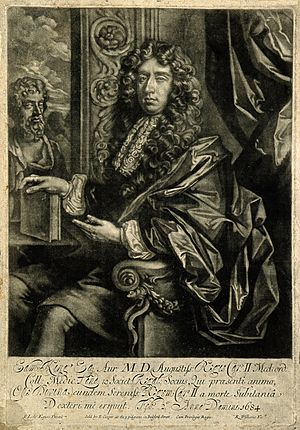Edmund King (physician) facts for kids
Sir Edmund King (born around 1630, died 1709) was an important English surgeon and doctor. He was known for his exciting experiments and for being the personal doctor to King Charles II of England.
Contents
The Life of Edmund King
Edmund King was born in 1630 in Northampton. His father was also a surgeon and doctor. Edmund became a surgeon in London after finishing his training.
King's Early Career and Home
He first lived in an area called Little Britain, London. In his house, he had a special collection of medical items, almost like a small museum. He loved showing it to students. He kept dried body parts, like a specific valve from the intestines, pressed in a large book. He also studied animals and human bodies by dissecting them. This helped him learn how living things worked.
Becoming a Royal Doctor
Around 1665, King moved to Hatton Garden in London. He got married in 1666. That same year, he was chosen to be a Fellow of the Royal Society. This was a big honor for scientists. He also earned his medical degree (M.D.) and later became a fellow of the College of Physicians of London. In 1676, he was knighted and became a doctor to the King.
Saving King Charles II
On February 2, 1685, King Charles II became very ill. Dr. King was called to see him. The King was speaking strangely. Dr. King returned later and saw the King suddenly collapse. Dr. King quickly bled the King, which was a common medical practice then. The King slowly woke up. Other doctors agreed with Dr. King's quick action. The King's advisors suggested Dr. King should get a large reward of £1,000, but he never received the money.
Later Years and Friends
Dr. King had a very busy medical practice. He worked until he was 72 years old. After retiring, he spent more time in the countryside. In 1701, he became too weak to care for his patient, the old poet Charles Sedley. He passed this patient to another famous doctor, Sir Hans Sloane. Dr. King died in Hatton Garden in 1709. He knew many important people, including Robert Boyle, a famous scientist. Some of his experiments took place at Arundel House in London.
Edmund King's Scientific Work
Sir Edmund King was a curious scientist who did many experiments. He often shared his findings in a famous science magazine called Philosophical Transactions.
Microscopic Discoveries
In 1666, King wrote about the soft parts of the body. He used a microscope to see that these parts had many tiny blood vessels. In 1669, he used his microscope again. He showed that glands, which are organs that make and release substances, were made only of tubes and vessels.
Blood Transfusion Experiments
In 1667, King wrote a long report about a blood transfusion. He moved blood from a calf into a sheep. He wanted to see if one animal could live with the blood of another. He used a special setup of pipes and quills for this experiment.
King also worked with other scientists like Robert Hooke on how living things breathe. In November 1667, King and Richard Lower tried a bold experiment. They transfused sheep's blood into a man. However, they stopped this research in 1668 after hearing about a death in France from a similar experiment.
Studying Insects and the Human Body
King also studied insects. In 1667, he wrote about ants. In 1670, he wrote about leaf cutter bees. He looked at ant eggs under a microscope and studied ant nests.
In 1686, King published a report about the autopsy of a man named Robert Bacon. This man had a hardened pineal gland in his brain, and stones in his kidneys and gallbladder. King mentioned that he had dissected over one hundred brains in his life. A famous doctor named Thomas Willis praised King's dissections in his own book. In 1688, King published another paper. It described the tube-like structure of reproductive glands in men, guinea pigs, and bulls.


